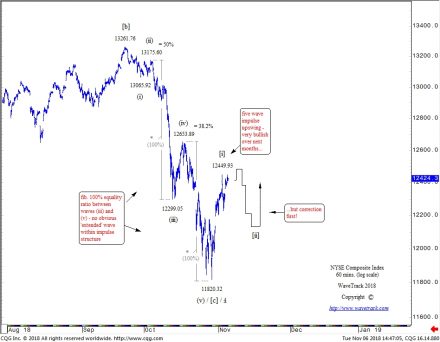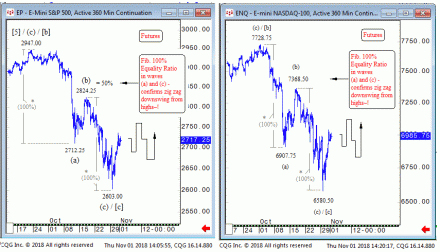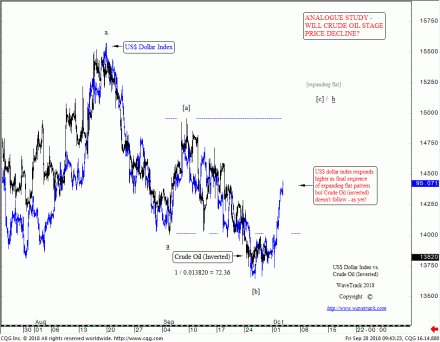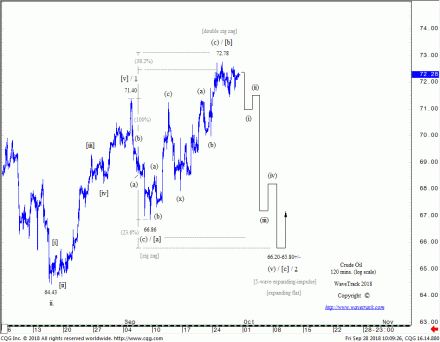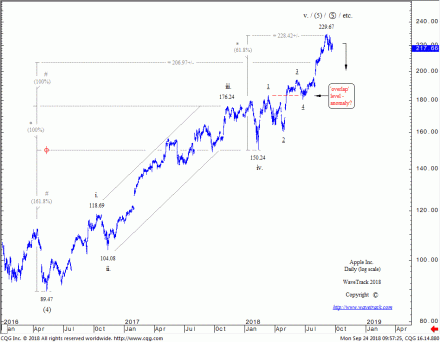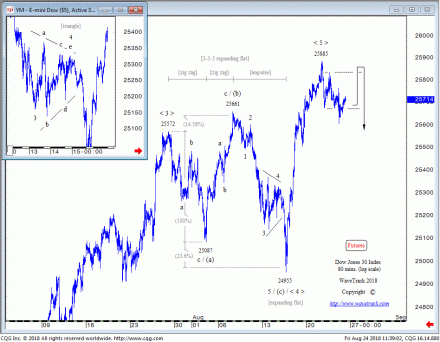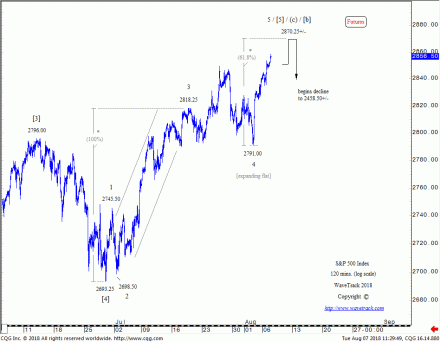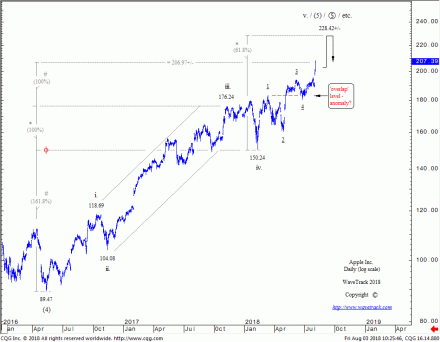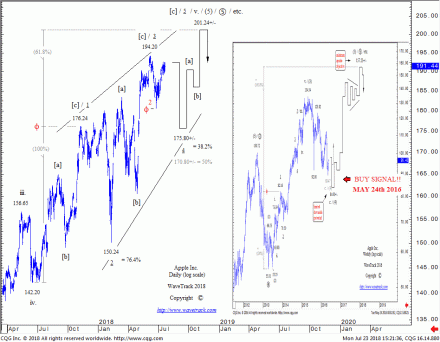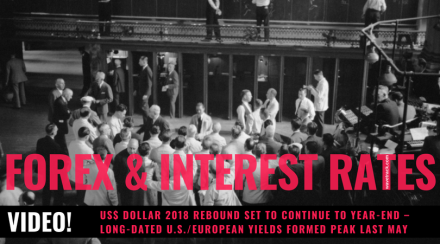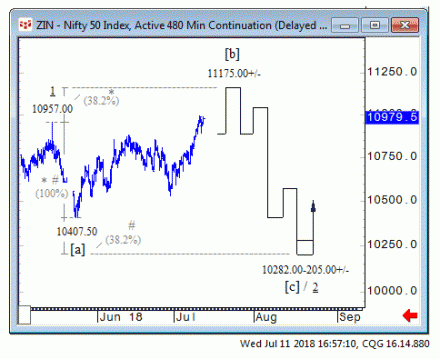NYSE Composite Index – Latest Development
by WaveTrack International| November 6, 2018 | No Comments
NYSE Composite Index – Fib. 100% Equality Ratio in Waves (iii) – (v) – No ‘Extended’ Wave
The Elliott Wave pattern development within the third phase of U.S. stock index declines during September/October’s sell-off varied according to each index’s performance from earlier this year. For example, the large-caps like the SP500 and Dow Jones (DJAI) declined into three wave patterns. In zig zags to be precise, from the late-Sep./early-Oct. highs as wave [c] within a developing triangle. These lows terminated in late-October but above the February lows. In this way reflecting their outperformance during April’s strong advances that broke above the January highs.
Other indices like the underperforming Russell 2000 small-cap index declined during September/October’s sell-off into a five wave impulse pattern. This reflected its underperformance and an entirely different corrective pattern. In this case, a running flat, unfolding from last January’s high.
The NYSE Composite index was one of the underperforming indices for this year. It unfolded into a zig zag pattern, [a]-[b]-[c] and one of the exceptions by breaking below the Feb’18 lows in wave [c] ending at 11820.32 – see fig #1.
Wave [c] unfolded into a necessary five wave impulse pattern from September’s high of 13261.76 subdividing (i)-(ii)-(iii)-(iv)-(v). What was interesting from a Ratio/Proportion basis was that there was no ‘extended’ wave in this sequence. Rather, waves (iii) and (v) measured equally by a fib. 100% equality ratio. That’s somewhat unusual because R.N. Elliott stated that one wave must ‘extend’ or measure larger than the other two. But occasionally, this hasn’t occurred as this example proves. Although this is statistically uncommon, it’s enough to qualify his statement as a ‘guideline’ rather than a ‘rule’.
NYSE Composite Index – Looking Ahead
With this year’s zig zag decline out of the way, the NYSE Composite index, like the others, can now begin a multi-month recovery, extending the bull market, impulse uptrend that began from the Feb.’16 lows.
Shorter-term, the advance from 11820.32 has unfolded into an intra-hourly five wave impulse pattern ending last Friday at 12449.93 as minuette wave [i]. Wave [ii] has since begun a three wave counter-trend correction but this remains incomplete. Await some downside pull across the U.S. mid-term election results before the trend resumes higher.
What has the SP500 and Nasdaq 100 in common?
by WaveTrack International| November 1, 2018 | 5 Comments
Three Wave Zig Zag Decline Completed for SP500 + Nasdaq 100
The SP500’s decline from September’s high has completed a three wave zig zag corrective pattern into last Monday evening’s low of 2603.00. This development changes this year’s expanding flat into developing triangle pattern. Turning this into a bullish outlook from current levels through to year-end and into H1-2019. The Nasdaq 100 follows the same pattern. Ending into zig zag from October high at 6580.50 and again turning this into a bullish outlook into year-end.
This year’s declines from January’s highs have been labelled as unfolding into an expanding flat corrective pattern as minute wave 4. However, it is now changing into a triangle. See latest EW-Compass Report.
The original expanding flat patterns were labelled [a]-[b]-[c], subdividing [3]-[3]-[5]. They were requiring a five wave downswing from the late-September/early-October highs. Hence, for the SP500 from 2940.91 (cash) and 2947.00 (futures) and for the Nasdaq 100 from 7700.56 (cash) and 7728.75 (futures). But we’ve detected a visible three wave zig zag pattern unfolding in wave [c]’s decline rather than a developing five wave sequence. The two downswings from 2947.00-2712.25 and from 2824.25-2603.00 measure equally. In case of the SP500 by a fib. 100% equality ratio (see SP 500 – inset left) and for the Nasdaq 100 from 7728.75-6907.75 and 7368.50-6850.50 (see Nasdaq 100 – inset right). This fits the characteristic of the zig zag. It therefore ends wave [c] but within a developing triangle because a triangle is labelled [a]-[b]-[c]-[d]-[e] but importantly, subdivides [3]-[3]-[3]-[3]-[3].
Conclusion
These zig zags confirm a good recovery can begin as wave [d] within the triangle. As a result, the SP500’s upside targets are aiming towards 2855.75+/- and Nasdaq 100’s towards 7544.00+/- into year-end, perhaps into January. Looking ahead, the triangle confirms minute wave 4 and upon completion, wave 5’s push to record highs.
Bi-weekly updates on the SP500, Nasdaq 100, US Dollar Index, Crude Oil, EuroStoxx, Russell 2000, Dow Jones 30, Dax, ASX200 and more! Don’t miss WaveTrack’s regular updates in our bi-weekly EW-Compass Report! Ensure you’re tracking our Forex forecasts – subscribe online for the EW-COMPASS REPORT.
Visit us @ www.wavetrack.com and subsribe to our latest EW-COMPASS report!
US$ Dollar Gains After Fed – Shouldn’t Crude Oil Also Decline?
by WaveTrack International| September 28, 2018 | No Comments
US$ Dollar Gains After Fed – Shouldn’t Crude Oil Also Decline?
Following Wednesday’s Federal Reserve interest rate hike of 0.25% to 2.25%, the US$ dollar has pulled higher by 1.23% per cent from 93.95 to 95.11. The US$ dollar looks set to continue higher over the next week or two as the finalising sequence of the expanding flat pattern (see Twitter post 26th September 2018).
Now what about Crude Oil?
But the intriguing question now relates to Crude Oil – see fig #1.
As you can see from this analogue, there’s currently a high-negative correlation with the US$ dollar index. Even price-amplitudes are closely aligned. The US$ dollar index pulled higher through Wednesday/Thursday and continuing this advance today (Friday). However, Crude Oil has failed to respond lower in reaction to the stronger US$ dollar. Is there any obvious reason for this breakdown in the correlation?
From an Elliott Wave perspective, the exact same Elliott Wave count is applied to Crude Oil, where an expanding flat is unfolding from Crude Oil’s early-September high of 71.40 – see fig #2. Labelled [a]-[b]-[c]. Wave [a] declined into a zig zag ending at 66.86 on September 7th. And was followed by a double zig zag upswing as wave [b] into the Sep. 25th high of 72.78. If correct, as we believe, then it really should decline now as wave [c] towards levels of 66.20-65.80+/-.
Conclusion
Perhaps it’s simply a case of playing ‘catch-up’. However, delays in these types of set-ups are not uncommon. One might view the delay as a complete breakdown of the negative correlation. In this case, Crude Oil’s underlying uptrend is so strong that it’s able to withstand a shorter-term US$ dollar rally. But often, trading opportunities exist where the divergence is simply delayed. Consequently, Crude Oil will perhaps suddenly, trade sharply lower.
Differentiation between the two possibilities comes down to the qualitative assessment of Crude Oil’s pattern. September’s advance does certainly conform to a double zig zag pattern (66.86-72.78). Therefore, the probability that it can still decline as wave [c] to 66.20-65.80+/- is increased.
Risk/Reward becomes a factor in whatever trade set-up is taken. Ensure close stops are applied, e.g. Crude Oil above the fib. 38.2% extension level of wave [a]’s trading-range at 73.15 would probably negate this high area as wave [b] of the expanding flat.
Bi-weekly updates on the US Dollar Index, Crude Oil, SP500, EuroStoxx, Nasdaq 100, Russell 2000, Dow Jones 30, Dax, ASX200 and more! Don’t miss WaveTrack’s regular updates in our bi-weekly EW-Compass Report! Ensure you’re tracking our Forex forecasts – subscribe online for the EW-COMPASS REPORT.
Visit us @ www.wavetrack.com and subsribe to our latest EW-COMPASS report!
Apple Inc. – Right on Target!
by WaveTrack International| September 24, 2018 | 2 Comments
Apple Inc. Hits Upside Targets of 228.42+/- Then Stages Reversal-Signature!
The August 3rd update of Apple Inc. forecast upside price acceleration following the publication of strong quarterly earnings results. Elliott Wave analysis had identified this latest push to record highs as a concluding 5th wave within the five wave impulse pattern unfolding higher from February’s low of 150.24. But this was minor wave v. five within the larger impulse uptrend. This wave dates back to the May ’16 low of 89.47, labelled intermediate wave (5) which means a much larger uptrend was approaching completion.
Using fib-price-ratios, Apple Inc. was forecast higher from 207.39 ending minor wave v. five at 228.42+/-. The actual test of this price level occurred on September 5th at 229.67. It was derived where minor wave v. five unfolds by a common fib. 61.8% correlative ratio of waves i-iii one-three.
Since achieving this upside target for wave v. five of (5), Apple Inc. has now staged price-rejection. The subsequent reversal-signature confirms that a counter-trend decline has begun.
What Next?
The next question is how far can Apple Inc. decline in this correction? Intermediate wave (5)’s advance from the May ’16 low was also the concluding 5th wave of primary wave 5. It stretches back to the April ’13 low of 55.01. And primary wave 5 is also part of the longer-term impulse uptrend that began from the July ’82 low of 0.19. If correct, then Apple Inc. could begin a major correction lasting a decade or more. Returning prices back to low-double-digit levels! But is this likely at this juncture of the secular-bull uptrend? After all, the Nasdaq 100 is still some way off Elliott Wave upside targets of 11946.00+/- (see bi-annual video series).
Apple Inc. – Alternate Counts
Although Apple Inc.’s historical data begins in December 1980, this isn’t enough to verify an absolute terminal price-peak for ending its long-term uptrend. Major indices bottomed in 1974, six years earlier so we can only guess what Apple Inc. would have traded then. It makes a huge difference in Fibonacci-Price-Ratio measurements of the secular-bull uptrend and of course, the Elliott Wave pattern itself.
The current long-term wave analysis is therefore one of a few potentialities labelling primary wave 1 ending into the April ’91 high of 2.61, primary wave 2 into the Dec.’97 low of 0.45, primary wave 3 ending into the Sep.’12 high of 100.72 and now primary wave 5 completing in Sep.’18 at 229.67.
But what we can determine with some surety is that a five wave impulse upswing from the May ’16 low of 89.47 did end into the early-September high of 229.67 which at the very least, indicates a corrective retracement towards ‘fourth wave of preceding degree’ which is at the Feb.’18 level of 150.24.
One alternate count that prolongs Apple Inc.’s secular-bull uptrend relabels the intermediate degree subdivision of primary wave 5’s advance from the April ’13 low of 55.01 so that wave (1) ends into the April ’15 high of 134.54, wave (2) into the May ’16 low of 89.47, wave (3) into the Sep.’18 high of 229.67 with wave (4) now engaged in a corrective downswing towards the fib. 38.2% retracement level of 160.00+/-. Naturally, this decline would necessitate unfolding into a three wave pattern, or a multiple seven/eleven wave sequence to validate its corrective credentials so would be easily spotted and differentiated to a more bearish impulse pattern.
Conclusion
Apple Inc. has underperformed over the last weeks. In fact, coming bottom of the Dow Jones 30 index table of component stocks. Apple reached a decline of -2.8% per cent over the last week alone and down -6.25% per cent from the high. This is consistent action following the completion of the 5th wave at 229.67. However, it’s too early to verify Apple Inc.’s long-term consequences. This means for the time being, downside targets are at least towards the 160.00+/- area.
Are you trading the SP500, EuroStoxx, Nasdaq 100, Russell 2000, Dow Jones 30, Dax, FTSE100 or ASX200? Don’t miss WaveTrack’s regular updates in our bi-weekly EW-Compass Report! Ensure you’re tracking our Forex forecasts – subscribe online for the EW-COMPASS REPORT.
Visit us @ www.wavetrack.com and subsribe to our latest EW-COMPASS report!
Dow Jones – Expanding Flats + Triangles
by WaveTrack International| August 24, 2018 | 3 Comments
Elliott Wave Patterns – Expanding Flats + Triangles
Expanding Flats
This year’s corrective downswing in the Dow Futures from January’s high is of particular interest. Mainly, because its early-April low at 23344.50 briefly penetrated below the early-February low 23360.20. This allows an expanding flat to develop from the February low as a corrective sequence. At the same time confirming April’s advance as the third sequence of the pattern rather than part of a sustainable uptrend. (See latest EW-Compass Report). April’s advance is labelled wave (c) unfolding into an ending/expanding-diagonal.
The final stage of April’s diagonal can be seen approaching a terminal high into current levels. A perfectly formed expanding flat formed from the late-July high of 25572 (futures) into the mid-August low of 24955 – see fig #1. Labelled (a)-(b)-(c) subdividing 3-3-5. Wave (a) declined into a zig zag. Wave (b) rallied into another zig zag prior to wave (c)’s decline as a five wave impulse into the 24955 low.
Moreover, fib-price-ratios (FPR’s) are evident. Providing authenticity to the pattern – extending wave (a) by a fib. 14.58% ratio projects within a few points of wave (b)’s high – extending wave (a) by a fib. 23.6% ratio projects wave (c) to within a few points of the actual low.
Triangles
Within wave (c)’s impulse decline, 1-2-3-4-5, wave 4 can be seen unfolding into a triangle (see inset, top-left). We bring attention to this because triangle patterns are actually uncommon patterns in terms of recurrence/frequency and are often misidentified in the EW community. This example is a good example of an actual triangle.
It’s important to ensure that each wave within the triangle, a-b-c-d-e develops within a near-symmetrical formation with approximately equal boundary lines. This ensures each wave gets close to touching the upper and lower boundary lines. If one sequence is too short so that it doesn’t approach the boundary line, then it probably isn’t a triangle at all which means the analyst must look at other possible wave counts. The only exception is in wave ‘e’ when sometimes, it does fall short. However, none of the others should exhibit this aspect.
Conclusion
The Dow has since traded to a higher-high at 25885. And whilst it could extend a little higher, this existing high has done enough to end the 5th wave thrust from the mid-August low whilst ending the larger 5th within April’s diagonal and the expanding flat from February’s low. That’s bearish!
SP500 – Higher-Highs but Approaching a Terminal Peak
by WaveTrack International| August 7, 2018 | 4 Comments
Despite the SP500’s intra-hourly five wave impulse decline from the July 25th high of 2849.50, the index has manged to secure a higher-high this week. Something that shouldn’t have occurred if a new downtrend was about to begin. There’s only one explanation. The five wave pattern was the concluding sequence within an expanding flat correction. In this case, a-b-c where its three price-swings subdivide 3-3-5 with the five sequence ending at 2791.00 – see fig #1.
The expanding flat is then incorporated into the developing five wave upswing that began from the late-June low of 2693.25 as micro wave [5]. Subdividing 1-2-3-4-5, the expanding flat becomes wave 4 with wave 5 already in upside progress. The fib-price-ratio measurements project to 2870.25+/- where wave [5] unfolds by a fib. 61.8% ratio of waves 1-3. If the same ratio measurement is used but including the ‘b’ high within wave 4, then wave 5 could push as high as 2890.00+/- but this is seen as a lower probability event.
It’s worth noting that the recent five wave decline in the Nasdaq 100 (not shown) from 7530.00 to 7166.75 was too large to be incorporated as wave 4 within the same five wave upswing from the late-June low as the SP500. Which means there is a heightened probability it will crash lower from below the existing 7530.00 high.
Conclusion
April’s diagonal pattern remains the best description for this uptrend from 2553.80. Comparing this with other indices like the Nasdaq 100 simply reinforces the bearish implications. Even the Dow Jones Industrial Average which is simply attempting a retest of its late-February high is alerting to bearish divergence across the major U.S. indices. We anticipate a -12% per cent decline unfolding over the next few months.
Are you trading the SP500, EuroStoxx, Nasdaq 100, Russell 2000, Dow Jones 30, Dax, FTSE100 or ASX200? Don’t miss WaveTrack’s regular updates in our bi-weekly EW-Compass Report! Ensure you’re tracking our Forex forecasts – subscribe online for the EW-COMPASS REPORT.
Visit us @ www.wavetrack.com and subsribe to our latest EW-COMPASS report!
Apple Inc. Extends Uptrend Following Quarterly Results
by WaveTrack International| August 3, 2018 | 5 Comments
Apple Inc. Extends Uptrend Following Quarterly Results – Terminal High Projection to $228.42+/-
Apple Inc. published its latest quarterly earnings earlier this week with strong numbers. It caused the share price to leap beyond the nearby resistance illustrated in the diagonal pattern (see update dt. July 23rd).
• EPS: $2.34 vs. $2.18 (source: Thomson Reuters estimates)
• Revenue: $53.3 billion vs. $52.34 billion (source: Thomson Reuters estimates)
• iPhone sales: 41.3 million vs. 41.79 million (source: StreetAccount)
The diagonal pattern as minor wave v. five was constructed because of three wave activity contained in the two advancing sequences from June ’17 onwards. And because of ‘overlap’ in its more recent dip during last June’s sell-off from 194.20 to 180.73 (180.73 broke below the previous March high of 183.50). But this is now negated basis the recent thrust above the upper boundary line of the diagonal.
This revised wave count relabels minor wave v. five beginning from a later low traded in February ’18 at 150.24 as a five wave ‘expanding-impulse’ pattern. The only problem is the ‘overlap’ conundrum which is difficult to overcome. Unless a closing/line chart is used as a filter – no overlap occurs when using this test.
But it would indicate Apple Inc. continuing to push even higher, targeting 228.42+/-.
Apple Inc. + Fib-Price-Ratios
Minor wave v. five can be seen unfolding within the five wave expanding-impulse pattern of intermediate wave (5) that began its uptrend from the May ’16 low of 89.47 – this wave labelling hasn’t changed – only the location of minor wave v. five has. Now if minor wave iii. three ended into the Nov.’17 high at 176.24, then two fib-price-ratios are derived from extending minor waves i-iv one-four by a fib. 61.8% ratio to project wave v. five to 206.97+/- or taking a fib. 61.8% correlative ratio of waves i-iii one-three adding to iv. four which projects wave v. five to 228.42+/-.
Conclusion
Apple Inc. has certainly bucked the trend of the Nasdaq 100 index’s wave count which shows a more immediate topping formation with some stark downside potential during the coming months. It’s difficult to expect Apple Inc. to sustain its run higher for any significant length of time if the broader markets begin to trend lower – assuming the 228.42+/- target is realistic, then it must test this number within the next week or two so that it can then join the major indices in their downturn.
Apple Inc. Set To Complete Medium-Term Uptrend With Ending/Diagonal Pattern
by WaveTrack International| July 23, 2018 | 5 Comments
Apple Inc. Set To Complete Medium-Term Uptrend With Ending/Diagonal Pattern
Nasdaq 100
The Nasdaq 100 index tracking over the last several months identified February’s advance approaching the completion of a zig zag pattern. That’s a huge danger signal warning that January’s initial corrective decline remains incomplete. In Elliott Wave terms, January/February’s decline is simply the first sequence within a developing three wave expanding flat pattern. February/July’s zig zag advance is ending the second sequence now, with a third declining sequence about to begin with downside targets -19% per cent below the July high.
But there is always an updside to a downside! The good news is that after the expanding flat pattern has ended, as a 4th wave correction, a 5th wave will then develop the next stage of the larger uptrend, targeting higher-highs.
These price sequences have a direct but positive correlation to Apple Inc.’s price development. Interestingly, even though its Elliott Wave pattern is entirely different.
Apple Inc.
Apple Inc. has a component weighting in the Nasdaq 100 of 11.306% per cent. It is indeed a key indicator of the general trend. Just over 2-years ago, on May 24th 2016, we issued a new buy-signal for Apple Inc. as it was just ending an intermediate degree 4th wave retracement at 96.43 having touched a low at 89.47. Since then, the stock has traded up to 194.20, a gain of 101% per cent – see fig #1 – inset, right. But what next?
Intermediate wave (5)’s advance from 89.47 has unfolded into a five wave expanding-impulse pattern, i-ii-iii-iv-v. But interestingly, the final advance as minor wave v. five has been identified as unfolding into a five wave diagonal-impulse pattern. Specifically, an ending/contracting-diagonal – see fig #1 – foreground, left.
Apple Inc. and the Elliott Wave Ending Diagonal Pattern
The diagonal has its characteristic wedge-shaped form. It is contracting as it moves towards completion, labelled in minute degree, 1-2-3-4-5. An ‘ending’ type diagonal like this one, where it is ending the larger uptrend as a fifth wave means its impulse waves, 1-3-5 have a tendency to subdivide into zig zags (or multiples). For example [a]-[b]-[c] which is very evident in Apple Inc.’s advances that began the diagonal from the June ’17 low. It is this characteristic that specifically endorses the diagonal, setting itself apart from just about any other pattern in Elliott’s compendium.
This analysis identifies a 3rd wave high as minute wave 3 ending into the June ’18 high of 194.20. However, the 4th wave, minute wave 4 remains incomplete to the downside. The late-June decline to 180.73 was not enough to complete the entirety of wave 4 – more downside is necessary. This 4th wave is labelled as unfolding into a zig zag where the final sequence pulls prices lower from around current levels, targeting 175.80+/-.
Apple Inc. and Fibonacci Price Ratios
This is derived by extending the 180.73 decline by a fib. 38.2% ratio. It tallies with the fib. 38.2% retracement of wave 3 three’s advance. Thus forming a fib-price-ratio convergence-matrix of support at this area. A fib. 61.8% ratio would otherwise extend this 4th wave towards 170.80+/- but a lower downside attempt like this is time-dependent. It will need to decline fairly rapidly so as to maintain the correct angle of the lower boundary-line of the diagonal.
This 4th wave decline correlates to the Nasdaq 100’s expected decline of -19% per cent referred to earlier. The percentages don’t exactly match. Apple Inc. would drop by only -9.4% per cent to 175.80+/- or -12.0% per cent to 170.80+/-, but that simply means it will outperform its peers.
Looking Ahead
Once the 4th waves for the Nasdaq 100 and Apple Inc. are out of the way, a 5th wave advance can begin for both. Apple Inc.’s upside target as minute wave 5 within the diagonal result in gains of +14-18% per cent – impressive!. Definitely, one to keep watching!
Are you trading the SP500, EuroStoxx, Nasdaq100, Russell 2000, Dow Jones 30, Dax, FTSE100, Shanghai Composite, Hang Seng or ASX200? Don’t miss WaveTrack’s regular updates in our bi-weekly EW-Compass Report! Ensure you’re tracking our Forex forecasts – subscribe online for the EW-COMPASS REPORT.
Visit us @ www.wavetrack.com and subsribe to our latest EW-COMPASS report!
Currencies & Interest Rates 2018 Video Release
by WaveTrack International| July 20, 2018 | No Comments
PART III – CURRENCIES & INTEREST RATES
US$ Dollar 2018 Rebound Set to Continue to Year-End – Long-Dated U.S./European Yields Formed Peak Last May
INCLUDES ANALYSIS ON MAJOR US$ DOLLAR PAIRS/CROSSES – ASIAN/EM CURRENCIES – MEDIUM-TERM CYCLES – LONG-DATED YIELDS US/EUROPE/JAPAN + SPREADS
We’re pleased to announce the publication of WaveTrack’s mid-year 2018 video updates of medium-term ELLIOTT WAVE price-forecasts. Today’s release is PART III, CURRENCIES & INTEREST RATES – Parts I & II were released during the last month – please contact us for information.
• PART I – STOCK INDICES – out now!
• PART II – COMMODITIES – out now!
• PART III – CURRENCIES & INTEREST RATES – out now!
January’s Forecasts for 2018 – CURRENCIES REVIEW
The Annual 2018 CURRENCIES & INTEREST RATES report commented ‘…Despite consensus opinion that the dollar will continue to trend lower during the coming year, the completion of a five wave impulse decline will in contrast, open the way for a multi-month corrective bounce to unfold. Analysis projects a fib. 50% retracement towards 95.42+/- over the next several months…’.
The problem with contrarian forecasts is that it’s so binary – either right or wrong which in terms of probability, is insufficient in itself because it comes wrapped in human pre-conception. But when applied with the predictive laws inherent in the Elliott Wave Principle, it becomes a powerful ally. The US$ dollar index ended that five wave impulse downtrend into February’s low of 88.26 – it has since traded higher to 95.52!
The same theme of a US$ dollar directional change was also translated across all the other major dollar pairs. But when it came to dealing with a strengthening US$ dollar through 2018, trouble was brewing for Emerging Market/Commodity related currencies. Last January’s report noted ‘…Emerging Market currencies, particularly those traded within the Asian ADXY index are trending higher from the Dec.’16 lows but again, will undergo a weakening period lasting several months before the medium-term uptrend resumes…’.
How did these Elliott Wave price-forecasts pan out?
As we already know, the benchmark US$ dollar index ended its five wave impulse decline into last February’s low at 88.26 and yes, it has subsequently traded up to targets of 95.42+/- with amazing accuracy. The Euro/US$ was forecast ending its equivalent five wave upswing from last year’s low, then staging a counter-trend decline – the Euro/US$ has since traded down from 1.2556 to 1.1509, a decline of -8.3% per cent. Naturally, if such large currency movements are forecast correctly, then there’s a pretty good chance of anticipating the right direction and amplitude for many other US$ dollar pairs and crosses.
But one of the stand-out forecasts for 2018 was the realisation that a strengthening US$ dollar would cause severe declines for the Emerging Market and Commodity-based currencies.
Currencies like the Brazilian Real have seen the weakest response to a strengthening US$ dollar, partly because of political upheaval but because of a commodity price meltdown.
In Asia, the ADXY Asian Dollar index was forecast last January to begin a sharp counter-trend decline from the 112.20 level – this was expected because the US$ dollar index was due to begin an upside recovery. And sure enough, the index has since declined by -5.4% per cent but is now levelling off.
China’s Renminbi was forecast to end a corrective decline towards 6.1050+/- then resume its larger uptrend. We couldn’t know why such a large upswing for the US$/CNY would unfold basis fundamentals but it later became obvious when the exchange rate ended at 6.2432 then flipped up to 6.6800 early-July as President Trump’s trade war entered the retaliation phase with China.
There were many more forecasts from January’s report that hinged upon a return to US$ dollar strength, but these are just a few examples – many others followed the same theme.
January’s Forecasts for 2018 – INTEREST RATES REVIEW
The Annual 2018 CURRENCIES & INTEREST RATES report commented ‘…The July ’16 troughs in U.S. and European yields represent the beginning of the next 30-35-year uptrend cycle. The recent break for the US10yr treasury yield above the 2017…indicates further upside potential into the end of Q1 ’18, beginning of Q2 targeting 3.360+/-…Once completed, a multi-month corrective decline would then begin, pulling yields sharply lower…The US10yr TIPS Breakeven Inflation Rate Spread indicates an interim peak forming at the same time as treasury yields…This suggests worries over the reemergence of inflationary pressures will abate for a while…In Europe, the European Central Banks relaxed approach to inflation means it remains with its existing QE programme…’.
How did these Elliott Wave price-forecasts pan out?
US10yr treasury yields began the year at 2.461% with upside targets towards 3.360+/- to complete the five wave uptrend that began from the July ’16 low of 1.316%. The actual peak came up slightly short though, ending at 3.127% into May’s high – it then declined rapidly to 2.748% later that month.
The US10yr TIPS Breakeven Inflation Rate Spread began the year trading at 2.075% with upside targets of 2.177%. It traded up to 2.182% last April and has since edged lower at 2.097% to begin a multi-month correction.
In Europe, the benchmark DE10yr yield has also ended a multi-year five wave uptrend that began from the July ’16 lows into February’s high of 0.806%. It has since declined rapidly as part of a multi-month correction to 0.182. The ECB has continued its easy monetary policies despite pressure from Germany’s Bundesbank to begin a tightening phase.
What Next H2 2018?
In this latest mid-year PART III 2018 video, the CURRENCIES section has been expanded upon to include several new currency crosses in addition to the major G8 currency pairs. Medium-term cycles are updated along with the very latest COT Aggregated Position Reports for the US$ Dollar, Euro, British Pound/Sterling, Yen, Aussie Dollar, and Canadian Dollar. The video begins by reviewing the 15.6-year and 7.8-year US$ dollar cycles, their current location and trend, how they correspond to the medium-term Elliott Wave counts. The same analysis is conducted for the Euro/US$ before updating price-forecasts and Fibonacci-Price-Ratio targets for the remaining G8 currencies.
Analysis then moves through the Euro-crosses, British Pound/Sterling crosses, before reaching the final segment of Asian/Emerging Market Currencies against the US$ dollar. There is also a weekly time-series forecast for Bitcoin!
A total of 47 currency charts.
The INTEREST RATES section begins with analysis of the long-term cycle with data on the 30yr yield dating back to the year 1760’s (250+ years!).
An overlay of the US30yr yield is added with Elliott Wave counts illustrating the previous Inflation-Peak cycle and the following Deflationary era ending in 2016.
EW analysis continues with the US10yr, US05yr and US02yr yields, comparison studies revealing the next major yield trends. The U.S. 10-year INFLATION TIPS is updated which is really important because of the recent rise in inflationary pressures.
Moving on to Europe, we examine the impact of the continuing easy-monetary policies of the European Central Bank with the DE10yr yield, its trend and whether it will still be used as a safe-harbour in the event of a new Italian political crisis. In fact, we add the Elliott Wave analysis for the ITY10yr yield before concluding with a look at the long-term Japanese JPY10yr yield with data that begins from the year-1930’s onwards!
A total of 18 interest rates charts
This new mid-year 2018 CURRENCIES & INTEREST RATES video is like nothing you’ve seen anywhere else in the world – it’s unique to WaveTrack International, how we foresee trends developing through the lens of Elliott Wave Principle (EWP) and how its forecasts correlate with Cycles and other asset classes from around the world.
We invite you to take this next part of our financial journey with us – video subscription details are below – just follow the links and we’ll see you soon!
Most sincerely,
Peter Goodburn
Founder and Chief Elliott Wave Analyst
WaveTrack International
The contents of this CURRENCIES & INTEREST RATES VIDEO include Elliott Wave analysis for over 65 charts explained during this in-depth video broadcast over 2 hours:
Currencies (47 charts):
• US$ Index + Cycles
• Euro/US$ + Cycles
• Stlg/US$
• US$/Yen
• AUD/US$
• NZD/US$
• AUD/NZD
• US$/CAD
• Euro/Stlg
• Euro/CHF
• Euro/Yen
• Asian ADXY
• US$/IDR
• US$/MXN
• US$/ZAR
• Stlg/YEN
• Stlg/ZAR
• Stlg/AUD
• US$/BRL
• US$/RUB
• US$/PLZ
• US$/CNY
• Bitcoin
Interest Rates (18 charts):
• US30yr Yield + Cycles
• US10yr Yield
• US5yr Yield
• US2yr Yield
• US10yr TIPS Break Even Inflation Rate
• DE10yr Yield + Spreads
• ITY10yr Yield
• JPY10yr Yield
CONTACT US NOW VIA EMAIL – SELECT YOUR PACKAGE
Single Video – *$48.00 – PART III CURRENCIES + INTEREST RATES VIDEO (July 2018)
Triple Package offer – *$96.00 (saving 33%)! – PART I – PART II – PART III (June/July 2018)
*(additional VAT may be added depending on your country – currently US, Canada, Asia have no added VAT but most European countries do)
PART III will be available in a few weeks’ time (2018!) – we’re working on it!
HOW TO PURCHASE THE VIDEO FORECAST?
To receive your VIDEO UPDATE please click here to contact us.
– Please state if you wish to purchase the SINGLE VIDEO for CURRENCIES + INTEREST RATES for USD *48.00?
– Or opt for the TRIPLE PACKAGE for USD *96.00 in total?
– Next we will send you a PayPal payment request and provide you with the video link & PDF report once confirmed.
*(additional VAT may be added depending on your country or residence. Currently, the US, Canada, Asia have no added VAT but most European countries do)
Visit us @ www.wavetrack.com
NIFTY 50 BREAKS HIGHER – BUT PART OF EXPANDING FLAT
by WaveTrack International| July 11, 2018 | 5 Comments
• The Nifty 50 has just broken above the May high. However, it is unfolding ina ann expanding flat from 10957.00 as minute wave 2. This allows a -8.6% decline during next couple of months
The Nifty 50 has broken above the May high of 10957.00 which negates declines to 9795.00+/- as the continuation of January’s zig zag corrective downswing. This revised count relabels the correction as ending last March at 9903.00 as minor wave iv. four within the Feb.’16 impulse uptrend as part of intermediate wave (5).
Minor wave v. five begins with minute wave 1 ending into the May high at 10957.00. Yet, wave 2 is most likely unfolding into an expanding flat – see fig #1. This requires a more immediate upside test towards 11175.00+/-. But afterwards expect a decline to 10282.00-205.00+/- before completion and a resumption of the larger uptrend.
Regular updates for India’s Nifty 50 are available via WaveTrack’s bi-weekly Elliott Wave Compass report – click here
And in our latest Mid-Year Stock Indices Video – click here and see below.
CONTACT US NOW VIA EMAIL – SELECT YOUR PACKAGE
Single Video – *$48.00 – PART I STOCK INDICES (June/July 2018)
Triple Package offer – *$96.00 (saving 33%)! – PART I – PART II – PART III (June/July 2018)
*(additional VAT may be added depending on your country – currently US, Canada, Asia have no added VAT but most European countries do)
PARTS II & III will be available in a few weeks’ time (2018!) – we’re working on it!
HOW CAN YOU RECEIVE THE VIDEO FORECAST?
To receive your VIDEO UPDATE please click here to contact us.
– Please state if you wish to purchase the SINGLE VIDEO for STOCK INDICES for USD *48.00?
– Or opt for the TRIPLE PACKAGE for USD *96.00 in total?
– Next we will send you a PayPal payment request and provide you with the video link & PDF report once confirmed.
*(additional VAT may be added depending on your country or residence. Currently, the US, Canada, Asia have no added VAT but most European countries do)
We’re sure you’ll reap the benefits – don’t forget to contact us with any Elliott Wave questions – Peter is always keen to hear you views, queries and comments.
Most sincerely,
WaveTrack’s Elliott Wave Team
Visit us @ www.wavetrack.com
« go back — keep looking »